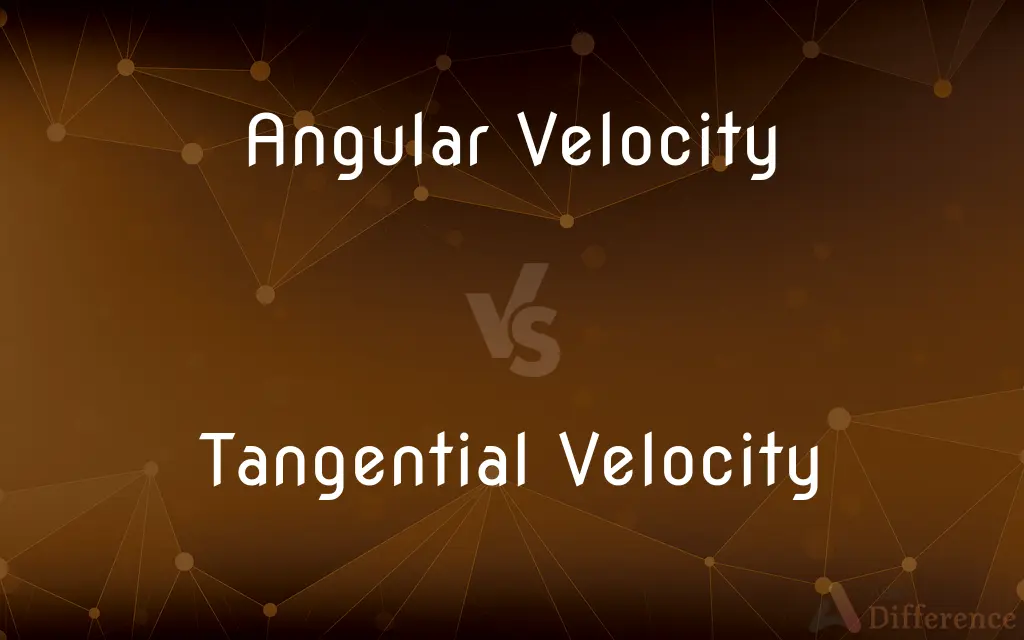Angular Velocity vs. Tangential Velocity — What's the Difference?
Edited by Tayyaba Rehman — By Fiza Rafique — Published on December 28, 2023
Angular Velocity measures an object's rotational speed around a fixed axis, while Tangential Velocity refers to the linear speed at a point on a rotating object.

Difference Between Angular Velocity and Tangential Velocity
Table of Contents
ADVERTISEMENT
Key Differences
Angular Velocity represents how fast an object rotates or revolves relative to a central point. It is typically measured in radians per second or degrees per second. In contrast, Tangential Velocity refers to the actual speed of a specific point on a rotating object, measured in linear terms such as meters per second.
Think of Angular Velocity as the speed at which a point rotates around a circle, while Tangential Velocity is how fast that point moves along the circumference of that circle. In essence, Angular Velocity gives a measure of the rotation itself, whereas Tangential Velocity provides insight into the linear movement due to that rotation. It's worth noting that Tangential Velocity will vary based on how far the point is from the center: the farther out, the greater the tangential speed for a given angular speed.
Both Angular Velocity and Tangential Velocity are essential in fields like physics and engineering, especially when dealing with rotating systems or objects.
Comparison Chart
Nature of Measurement
Rotational speed around an axis.
Linear speed of a point on a rotating object.
Units
Radians per second, degrees per second.
Meters per second, feet per second, etc.
ADVERTISEMENT
Dependence on Radius
Independent of radius.
Directly proportional to radius.
Representation
Describes rotation itself.
Describes linear movement due to rotation.
Relation
Constant for a given rotation.
Varies based on the point's distance from the center of rotation.
Compare with Definitions
Angular Velocity
Describes the rotation of an object around its central axis.
The planet's Angular Velocity is crucial for determining the length of its day.
Tangential Velocity
Represents the actual speed of rotation in linear terms.
At higher Tangential Velocities, the water was flung out from the spinning bucket.
Angular Velocity
A measure of how fast an object rotates around a point.
The fan's blades have an Angular Velocity of 20 radians per second.
Tangential Velocity
Speed at which a point travels along the path of rotation.
As the record spins, each point has its own Tangential Velocity.
Angular Velocity
Speed at which an angle changes during rotation.
The Earth has a nearly constant Angular Velocity of 360° every 24 hours.
Tangential Velocity
The linear speed of a point on a rotating object.
The outer edge of the wheel has a higher Tangential Velocity than points closer to the center.
Angular Velocity
Rate of change of the angular displacement with time.
As the skater tightened her spin, her Angular Velocity increased.
Tangential Velocity
Provides a measure of linear motion due to rotation.
The Tangential Velocity of the carousel horse is relatively low.
Angular Velocity
Can be constant or variable based on the object's rotation.
The dancer varied her Angular Velocity during the performance.
Tangential Velocity
Dependent on the radius and Angular Velocity of the object.
Increasing the radius while keeping Angular Velocity constant will increase the Tangential Velocity.
Common Curiosities
Can two points on a rotating disk have the same Angular Velocity?
Yes, all points on a solid rotating disk have the same Angular Velocity.
What's the main difference between Angular Velocity and Tangential Velocity?
Angular Velocity measures rotational speed, while Tangential Velocity measures linear speed at a point on a rotating object.
Can a rotating object have zero Angular Velocity?
Yes, if the object is stationary and not rotating.
Which is more affected by changes in radius: Angular Velocity or Tangential Velocity?
Tangential Velocity, as it's directly proportional to the radius.
Can Angular Velocity be negative?
Yes, a negative value indicates rotation in the opposite direction.
How does Tangential Velocity relate to centripetal force?
Centripetal force is proportional to the square of Tangential Velocity.
How are Angular Velocity and Tangential Velocity related mathematically?
Tangential Velocity = Angular Velocity x Radius.
How does the Tangential Velocity of a point change with its distance from the center of rotation?
Tangential Velocity increases with distance from the center.
Is it possible for an object to have a high Angular Velocity but a low Tangential Velocity?
No, given a non-zero radius, a high Angular Velocity will result in a high Tangential Velocity.
Which velocity is typically greater on the edge of a rotating wheel: Angular or Tangential?
Tangential Velocity is greater at the edge, while all points share the same Angular Velocity.
Why is understanding Angular Velocity important in astronomy?
It's crucial for understanding the rotation rates of celestial bodies.
What tools can measure Angular Velocity?
Gyroscopes and tachometers can measure Angular Velocity.
Can two points on a rotating object have different Tangential Velocities?
Yes, points farther from the center will have a higher Tangential Velocity.
What happens to Tangential Velocity if Angular Velocity doubles?
Tangential Velocity will also double, given a constant radius.
Can Tangential Velocity be greater than Angular Velocity?
Yes, as they have different units. Comparing their magnitudes without context isn't meaningful.
Share Your Discovery

Previous Comparison
Epithelial Cells vs. Mesenchymal Cells
Next Comparison
Oligosaccharides vs. PolysaccharidesAuthor Spotlight
Written by
Fiza RafiqueFiza Rafique is a skilled content writer at AskDifference.com, where she meticulously refines and enhances written pieces. Drawing from her vast editorial expertise, Fiza ensures clarity, accuracy, and precision in every article. Passionate about language, she continually seeks to elevate the quality of content for readers worldwide.
Edited by
Tayyaba RehmanTayyaba Rehman is a distinguished writer, currently serving as a primary contributor to askdifference.com. As a researcher in semantics and etymology, Tayyaba's passion for the complexity of languages and their distinctions has found a perfect home on the platform. Tayyaba delves into the intricacies of language, distinguishing between commonly confused words and phrases, thereby providing clarity for readers worldwide.













































